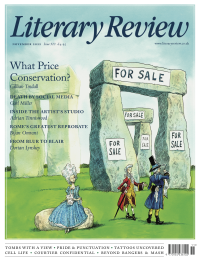Adrian Tinniswood
Think of the Live Models!
The Artist’s Studio: A Cultural History
By James Hall
Thames & Hudson 288pp £30
I have to confess to taking a voyeuristic pleasure in visiting the places where writers have produced their work. I’ve soaked up the atmosphere in Vita Sackville-West’s writing room, perched like an eyrie at the top of a tower at Sissinghurst. I’ve pressed my nose against the window of George Bernard Shaw’s revolving writing hut at the bottom of his garden in Ayot St Lawrence. I’ve channelled Churchill at Chartwell and rimed with the ancient mariner at Coleridge Cottage.
The art workshop is just as fascinating as the writer’s room; more so, in fact, because there one can usually see the tools used in the making, which are rather more interesting than a typewriter or a desk blotter. And best of all is when such places are still populated by makers. Think of the Minster Stoneyard in York, where a team of craftsmen and women shape gargoyles and finials in much the same way as their medieval forebears did (though with rather better saws and hoists, and modern dust extraction systems), or Hart Silversmiths in Chipping Campden, where you can watch as the descendants of C R Ashbee’s Guild of Handicraft still fashion everything from knives and forks to magnificent jewel-encrusted processional crosses (something of a niche market in this day and age, one feels).
The artist’s studio falls between the writing desk and the workbench, and it combines the best of both. It is a place where things have been made and where art – fine art – has been conceptualised, created and refined, and sometimes discarded. It might be a chic white box, a warehouse with paint-splattered walls or a back room in a terraced house with a decent north-facing window. Visitors to these places know that this painting or that statuette should stand alone, independent of its maker and the circumstances of its making, but can’t help themselves from reconstructing in imagination the act of creation.
James Hall’s The Artist’s Studio is a thorough exploration of artists’ workspaces. Billed as a cultural history, it combines cerebral and beautifully illustrated argument with encyclopedic information about artists, their working practices and their funny little ways. Hall starts early in time with Homer’s description in the Iliad

@Lit_Review
Follow Literary Review on Twitter
Twitter Feed
Alfred, Lord Tennyson is practically a byword for old-fashioned Victorian grandeur, rarely pictured without a cravat and a serious beard.
Seamus Perry tries to picture him as a younger man.
Seamus Perry - Before the Beard
Seamus Perry: Before the Beard - The Boundless Deep: Young Tennyson, Science, and the Crisis of Belief by Richard Holmes
literaryreview.co.uk
Novelist Muriel Spark had a tongue that could produce both sugar and poison. It’s no surprise, then, that her letters make for a brilliant read.
@claire_harman considers some of the most entertaining.
Claire Harman - Fighting Words
Claire Harman: Fighting Words - The Letters of Muriel Spark, Volume 1: 1944-1963 by Dan Gunn
literaryreview.co.uk
Of all the articles I’ve published in recent years, this is *by far* my favourite.
✍️ On childhood, memory, and the sea - for @Lit_Review :
https://literaryreview.co.uk/flotsam-and-jetsam